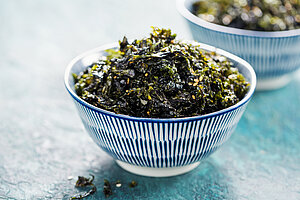The world is full of vegetation with the potential to increase the diversity of the human diet and deliver unique nutrients. Not only are we discovering distinctive flora all the time, but we’re finding new ways to use it.
While it’s normal to turn to plant life that grows on land, there’s also a whole world of vegetation flourishing underwater. Sea greens have been used throughout history by various cultures, especially island nations and countries with aquatic borders. How are they finding their way into food in innovative ways today?
 Nori
Nori
Made from a species of red algae, Nori is a type of seaweed that is dried and sold in sheets. It is most commonly used to wrap sushi rolls, but some people eat it alone as a snack or add it to salads, soups, or rice bowls.
For a new twist on the briny snacking potential of nori, consider toasting it to make thin chips. It could also be used as a crust on chicken or steak or as an ingredient that adds incredible umami flavor to creamy dips or hummus.
Kelp
Seaweed is a broad category encompassing a range of sea plants and algae. Kelp is the largest subcategory of seaweed, and there are several varieties. Which ones are popping up in the food world, and what makes each unique?
Kombu
This kelp grows naturally along the Pacific Rim, off the coast of Russia, China, Japan, and Australia. It can also be found off the west coast of North America, as well as South Africa, making it fairly prolific.
Kombu is rarely consumed raw because of the high iodine content, but this can be tempered through boiling or processing. It is sometimes pickled but more often dried and rehydrated to add to soups and salads, particularly in Japanese cuisine.
This particular variety of kelp is a rich, mossy green color, and the leaves are thicker and tougher than some other plants. What consumers tend to find most appealing is the umami flavor it adds to dishes, described as having a briny element and an earthy similarity to mushrooms.
Subscribe to In-sight to receive articles and reports directly to your inbox, CLICK HERE!
Arame
Found throughout the Pacific Ocean, this kelp variety is dark brown to black in color, with long, straggly strands. Most often sold as a dehydrated product, arame has a mild, almost sweet flavor and a yielding texture.
It rehydrates quickly and makes an ideal addition to salads, soups, and noodle or rice bowls. It can also add delicate flavor complexity to stir fry and sauces, providing a nice counterpoint to fried meat or tofu dishes.
Dulse
Perhaps the most notable feature of this kelp variety is the color, which is deep red to dark purple in hue. This alone makes it a beautiful addition to all kinds of dishes, but the salty, savory flavor profile is nothing to sniff at.
Sometimes compared to bacon, dulse is a tasty stand-in for meat, and the soft, leathery texture works well in salads, stews, tacos, and a range of other preparations. One creative way to use dulse is by frying or baking it into crispy, flavorful chips. It could also be added to baked goods like breads and scones.
Wakame
Another alga, similar to nori, this soft, silky, green seaweed offers a blend of sweet and umami flavors ideal for many preparations. Sometimes called sea mustard, wakame is frequently found in miso soup and seaweed salads. Like kombu, it is usually sold dehydrated to eliminate some iodine content.
Related: Japanese Food Trends on the Way to U.S. Markets
Seaweed Donuts
Transforming confections into savory delights is a hallmark of many Asian cuisines, but when Dunkin’ Donuts launched pork and seaweed donuts in China a decade ago, they probably didn’t know the trend would spread. When done right, the seaweed is subtle enough to add a bit of salty, savory appeal without smacking of brine.
Expanding Sea Greens to New Markets
In truth, sea greens are a market that bears much more exploration in western cuisines, considering how versatile seaweed and other vegetation can be. It can be added to a menu or manufacturing lineup in an incredible array of innovative ways.
To learn more about our products and insights, get in touch with our team at Symrise today, Contact us here!






